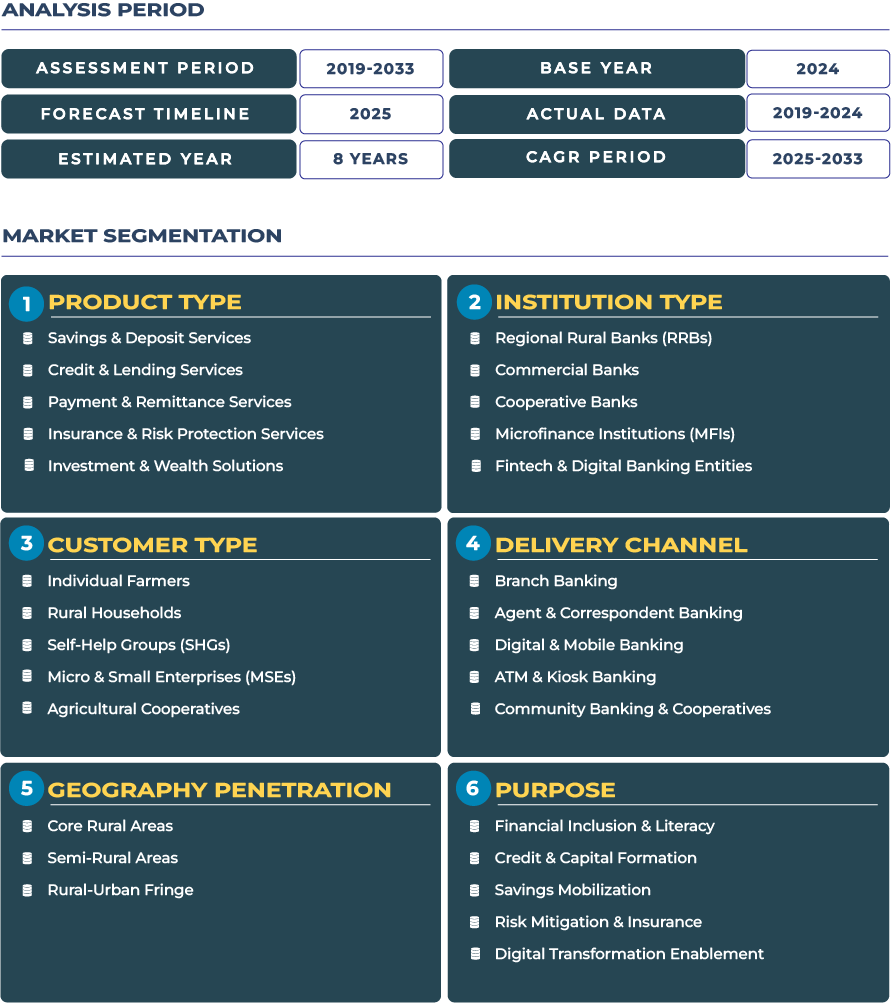Oman Rural Banking Market Outlook: Financing Water-Efficient Agriculture for a Sustainable Export Future
The Oman rural banking market is emerging as a cornerstone in the nation’s transition toward sustainable and water-efficient agribusiness. Positioned at the intersection of desert agriculture and maritime export corridors, Oman’s rural banks are increasingly financing innovations that redefine productivity in arid conditions. Under the national Oman Vision 2040 strategy, financial institutions are integrating credit models that link sustainability with export potential, from drip irrigation systems to micro-desalination units. As of 2025, the market is valued at USD 708.0 million and is projected to reach USD 939.9 million by 2033, expanding at a steady CAGR of 3.6%. This growth reflects rising credit demand from rural farmers, agritech startups, and cooperative exporters benefiting from Oman’s push toward self-reliance and regional food trade.
Note:* The market size refers to the total fees/revenue generated by banks through various services.
Oman Rural Banking Market Outlook: Financing Water-Efficient Agribusiness in a Resource-Constrained Landscape
Oman rural banking ecosystem is undergoing a structural transformation as it aligns with the country’s ambition to build a water-efficient agricultural economy. Local banks are channeling funds toward resource-optimized farming practices, particularly in date and citrus cultivation, which dominate the nation’s arid zones. Financial institutions such as National Bank of Oman and Central Bank of Oman are advancing specialized loan products and low-interest lines for rural entrepreneurs focusing on desalination-powered irrigation and cold-chain storage.
The focus on water efficiency has redefined credit scoring models, encouraging farmers to adopt technologies like precision irrigation and renewable-powered desalination plants. Meanwhile, the government’s agricultural export initiative promotes financing for logistics and packaging facilities to strengthen global trade competitiveness. The Oman rural banking industry, therefore, is not only financing crops but also nurturing a holistic rural ecosystem that integrates infrastructure, sustainability, and trade resilience.
Drivers & Restraints: Strategic Investments and Geographical Challenges Shape Growth Path
Investment in Water-Efficient Agriculture Anchors Market Expansion
The key driver for the Oman rural banking market lies in the nation’s growing emphasis on water-efficient agriculture and climate-adaptive rural lending. Banks are offering credit for solar desalination projects, drip irrigation networks, and integrated water-use monitoring systems. These initiatives align with the Ministry of Agriculture, Fisheries, and Water Resources’ strategy to improve agricultural productivity per cubic meter of water used. Additionally, Oman’s port infrastructure, particularly at Sohar and Duqm, has become a catalyst for rural export finance. By supporting logistics and rural cold-chain investments, the banking sector enhances rural producers’ global competitiveness, connecting interior farmers to GCC and Asian markets.
Limited Bankable Projects and Topographical Constraints Slow Credit Penetration
Despite positive trends, the rural banking sector faces structural constraints. Oman’s mountainous terrain and dispersed rural settlements limit large-scale mechanization and raise operating costs for financial service delivery. Many rural microenterprises still lack adequate credit history, making traditional lending less feasible. Further, the small domestic agricultural base restricts credit diversification, forcing banks to depend on guarantees or blended financing instruments. These challenges highlight the need for risk-mitigation mechanisms and digital credit evaluation frameworks to enhance rural bankability while maintaining prudent lending standards.
Trends & Opportunities: Rural Finance Shifts Toward Export-Linked and Green Lending Models
Water-Saving Credit Lines Transforming Date and Citrus Farming
A defining trend in the Oman rural banking landscape is the rise of green credit instruments designed to encourage water savings in key export crops. Rural banks have begun structuring repayment cycles aligned with harvest timelines, supporting farmers’ liquidity during off-seasons. Increasing demand for high-value date exports to Asia has also led to bundled financing that includes irrigation technology leasing, crop insurance, and export receivable management. The Oman Food Investment Holding Company has partnered with rural banks to facilitate access to project finance for sustainable agri-processing hubs.
Micro-Desalination Finance and Export Hub Lending Lead New Opportunities
Emerging opportunities in the Omani rural banking market lie in financing micro-desalination systems, integrated with drip networks for smallholder farms. These models offer measurable productivity improvements and water savings, thereby improving credit viability. Furthermore, the development of coastal fisheries has unlocked a new financing frontier, export-hub lending. By underwriting loans for cold storage, processing, and distribution facilities in rural coastal zones, banks are positioning Oman as a regional supplier of sustainable seafood. This creates a virtuous cycle of investment in infrastructure and rural livelihoods while supporting the country’s diversification vision.
Competitive Landscape: Local Banks Drive Innovation in Rural Credit and Export Finance
Oman rural banking sector is dominated by local players expanding their reach through digital and project-based financing solutions. Bank Muscat, National Bank of Oman, and Oman Development Bank have been instrumental in providing targeted financing for rural enterprises. The strategic shift toward bundled financing and export-linked credit demonstrates the sector’s adaptability. By integrating risk-sharing mechanisms and government-backed guarantees, Omani banks are reducing non-performing loan exposure while empowering rural borrowers to invest in modern agricultural infrastructure. The competitive landscape now leans toward innovation-driven partnerships between banks, agri-tech firms, and export cooperatives, signaling a maturing ecosystem prepared to scale rural transformation.







